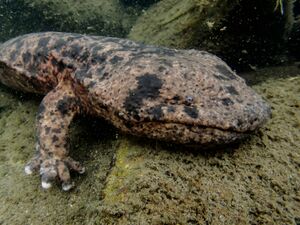Japanese giant salamander: Difference between revisions
Jump to navigation
Jump to search
| Line 30: | Line 30: | ||
== Diet == | == Diet == | ||
With the Japanese Giant Salamander living its entire life in the water the diet consists of freshwater fish, frogs, and crabs.<ref>{{| | With the Japanese Giant Salamander living its entire life in the water the diet consists of freshwater fish, frogs, and crabs. Due to the slow metabolism of the salamander the species can go without eating for days.<ref name="natlzoo">{{cite web|url=https://nationalzoo.si.edu/Animals/AsiaTrail/GiantSalamanders/|website=Smithsonian National Zoological Park|access-date=2016-06-13|title=Japanese Giant Salamander|archive-url=https://web.archive.org/web/20160624015515/http://nationalzoo.si.edu/Animals/AsiaTrail/GiantSalamanders/|archive-date=2016-06-24|url-status=dead}}</ref> | ||
== Behavior == | == Behavior == | ||
Revision as of 18:03, 10 May 2022

| |
| Kingdom: | Animalia |
|---|---|
| Phylum: | Chordata |
| Class: | Amphibia |
| Order: | Urodela |
| Family: | Cryptobranchidae |
| Genus: | Andrias |
| Species: | A. japonicus |
| Source: Integrated Taxonomic Information System[1] | |
Description
Diet
With the Japanese Giant Salamander living its entire life in the water the diet consists of freshwater fish, frogs, and crabs. Due to the slow metabolism of the salamander the species can go without eating for days.[2]
Behavior
Conservation
Due to the species being highly endemic, the biggest threat to the Japanese Giant Salamander is habitat loss.
References
- ↑ "Integrated Taxonomic Information System - Report", ITIS USGS Open-File Report 2006-1195: Nomenclature", USGS, n.d.. Retrieved 5/1/2022.
- ↑ “Discover How Scientists Have Recreated the Benefits of Insects' Compound Eyes as Compound Lenses.” Encyclopædia Britannica, Encyclopædia Britannica, Inc., https://www.britannica.com/video/216533/Artificial-bug-eyes-could-lead-to-new-vision-systems.